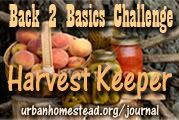When I was younger, my mother used to breed and show dogs. Several years ago, I wanted to work with large breed dog rescue, something that still tugs at my heart strings. But, when we started getting into the world of urban homesteading, I found something that spoke to not only my work with rescue, but also to my love of history and culture. Heirloom plants were the start, with originating dates that dated back for sometimes a couple hundred years. Breeds that have been nearly lost in the mass hybridization and genetic engineering (thanks you evil bastards Monsanto!). Reclaiming our right to grow our own food, collect our own seeds, this isn't just something novel to us .. this is a nation-wide, a world-wide movement! Thanks to dedicated work from people such as the Dervaes family, there are now movements like this: http://urbanhomestead.org/journal/2009/02/03/freedom-harvest-challenge --- Truly, amazingly, and mind-blowingly inspiring!!!
When we got chickens, when we made the decision to get chickens, I started off in my usual fashion .. research, more research, and more research. Those who know me know I can and will dominate a conversationg about chickens! One of the things that really blew my mind was that there were breeds of chickens, as well as other traditional livestock animals, that are on the brink of going extinct. We knew about the importance of heirloom seeds, but somehow heirloom/heritage animals hadn't really entered our minds. After all, there is already the polar bears, panda bears, wolves, and several other highly publicized animals keeping our worry squarely (and justly!) focused!
Three breeds of our chickens are on the ALBC, American Livestock Breeds Conservancy, watchlist. (http://www.albc-usa.org/cpl/wtchlist.html) Our Dark Brahma and Partridge Cochins are considered under watch; our Buff Orpington is considered a recovering breed; our Speckled Sussexes (which we ate for meat) were considered Threatened. We had intended to breed them, but that fell through.
I've been reading a fascinating book, Renewing America's Food Traditions by Gary Paul Nahan. Reading about not only grown foods that are endagered, but also raised foods and animals. Milking Devon Cattle, Silver Fox Rabbits, Tennessee Fainting Goats.
Mom may have bred dogs, I want to breed farm animals. I want to not only show the benefits of heirloom veggies, fruits, and herbs, but also the animals. Anyone who has raised chickens knows the shock registered by most people when they realize that eggs come in more shades than white and brown. Ours are two shades of brown - some that are speckled, pink, green, and blue. When we chose Speckled Sussex (with the hopes of breeding) as our meat birds, it was because over 100 years ago they were common table birds in England, renowned for their meat.
Intentionally or not, subconsciously or not, we have gone from being a nature and society over-flowing with diversity in foods, based on the seasons and the areas of the country they were originally from - representing the local peoples of those areas.
Until the fates change and we perhaps buy a farm where we're safe to raise agriculture of our choice, we're here. Living on our little plot of land, a block from Main Street. Doing what we can, when we can, living frugally, living consciously, teaching our children along the way. Small yes, bit by bit we'll grow and learn. The Blue Nymph .. our urban heirloom homestead.
Detect Fraud in Rental Applications and ID Proofs
2 months ago













1 comment:
Smaller populations mean smaller gene pools. My experience with heirloom sheep is that the frequency of fatal, heart-breaking birth defects is pretty high. Maybe some breeds were left behind b/c they were more prone to problems, harder to raise. It's not always evil modern agriculture, sometimes, even-if-it-sucks, its just practical farming.
Post a Comment